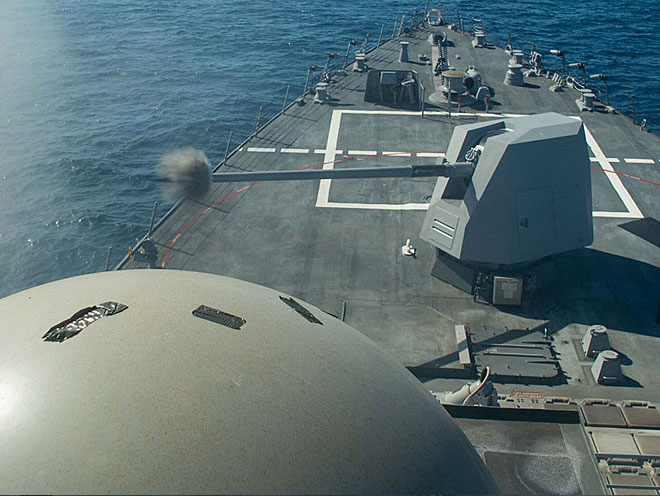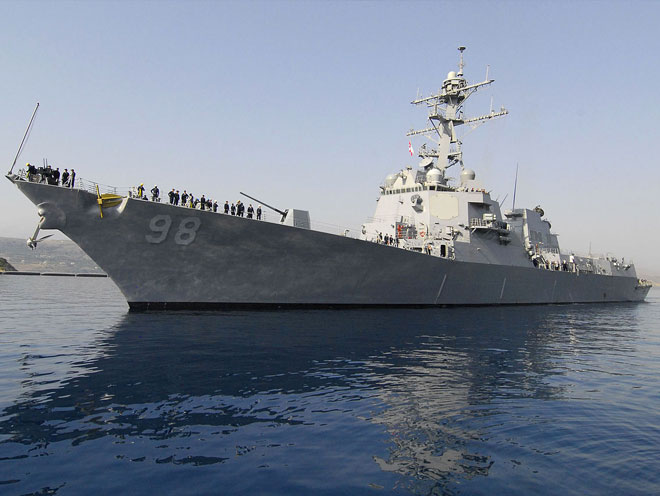
DDG 51 destroyers provide multi-mission capabilities, operating independently or as part of carrier strike groups, surface action groups, amphibious ready groups and replenishment groups.
Aegis guided missile destroyers are multi-mission surface combatants, capable of engaging targets on, above and below the surface.
New ships in this class have anti-ballistic missile capabilities as well.
The DDG’s all-steel construction provides a survivable platform. Ingalls shipbuilders incorporate lessons learned from previous ships to improve safety, quality cost and schedule requirements.
DDG FACTS
A DDG is 509 feet long with a 66-foot beam. It weighs 9,300 tons and takes approximately four years to build.
DDG class ships provide multi-mission offensive and defensive capabilities and can operate independently or as part of carrier strike groups, surface action groups, amphibious ready groups and underway replenishment groups.
They have a crew of more than 350 sailors.
(Learn More. The United States Navy (USN) is the naval warfare service branch of the United States Armed Forces and one of the seven uniformed services of the United States. Courtesy of ArmedForcesUpdate and YouTube. Posted on Jun 5, 2016)
A DDG Aegis guided missile destroyer is equipped with:
- 2 MK 41 vertical launching systems
- 1 5-inch gun turret
- 2 MK 32 triple-barrel torpedo mounts
- Advanced radar and sonar systems that allow it to engage targets in the air, on the sea and underwater.
- Four gas turbine engines that can reach a maximum speed of more than 30 knots.
Design & Construction

The Arleigh Burke class destroyers are the US Navy’s most powerful destroyer fleet.
These highly-capable, multi-mission ships conduct a variety of operations, from peacetime presence to national security.
The DDG 51 Class design is captured in a three-dimensional model and interfaced with the Computer-Aided Manufacturing (CAM) systems, in which numerically-controlled manufacturing equipment cut plate and bend pipe.
Ingalls Shipbuilding uses modular construction techniques pioneered by the shipyard in the 1970s and refined over the years to maximize shipyard throughput. During the construction of a DDG 51 destroyer, 72 structural assemblies (units) are integrated, forming 21 grand blocks.
These grand blocks are integrated, creating the ship’s hull modules 1, 2 and 3. The deckhouse is landed (module 4), piping systems installed, cable routed, equipment connected and systems readied for test.
The ship is moved to a drydock and launched in a 12-hour time period. Final outfitting and test is completed pier side.
Arleigh Burke class destroyers include 322 miles of cable, 185,000 feet of pipe and enough hull insulation (450,000 square feet) to cover the roof of the Superdome in New Orleans.
(Watch a time lapse of the translation and launch of the Arleigh Burke-class destroyer Ralph Johnson (DDG 114) over three days in December, 2015. Courtesy of Huntington Ingalls Industries and YouTube. Posted on Dec 15, 2015)
Armor is placed around vital combat systems and machinery spaces. Acoustic, infrared and radar signatures have been reduced, and vital shipboard systems are hardened against electromagnetic pulse and over-pressure damage.
In addition, a Collective Protection System guards against nuclear, chemical and biological agents.
Destroyers At Sea

The DDG 51-class Aegis guided missile destroyers provide a wide range of war fighting capabilities in multi-threat air, surface and subsurface environments.
These ships respond to Low Intensity Conflict/Coastal and Littoral Offshore Warfare (LIC/CALOW) scenarios as well as open-sea conflict independently or as units of Carrier Strike Groups (CSG), Expeditionary Strike Groups (ESG) and Missile Defense Action Groups.
The Arleigh Burke class destroyer is equipped with the Navy’s Aegis Combat System, the world’s foremost integrated naval weapon system which includes the AN/SPY-1D phased array radar, the most powerful air search radar in the Navy.
The AN/SPY-1D radar scans in all directions simultaneously to detect, track and engage hundreds of aircraft and missiles. State-of-the-art C4I (Command, Control, Communications, Computers and Intelligence) systems provide the Arleigh Burke class destroyer crew with total situational awareness.
When integrated with the Aegis Combat System, the Cooperative Engagement Capability (CEC) permits groups of ships and aircraft to link their radars to provide a composite picture of the battle space, effectively increasing the theater space.
The capability is designed to provide the Navy with a 21st Century fighting edge.
The Arleigh Burke class destroyer is a multi-mission combatant offering the most capable surface warships ever built, with the requisite weapons, electronics, helicopter support facilities, propulsion, auxiliary and survivability systems to successfully carry out the Navy’s missions.
History of American Destroyers
On November 24, 1902, a new era in U.S. Navy history began as its first destroyer, USS Bainbridge (DD 1), was commissioned.
USS Bainbridge was actually a torpedo boat destroyer. She was 250 feet in length, displaced 420 tons and had a top speed of 29 knots. She carried a crew of 75.
The Naval Act of 1916 authorized 50 destroyers built over a three year period. Less than a year later, the first U.S. warships reached the European theater at Queenstown, Ireland, to join the fight against Germany during World War I.
(USS Bainbridge is an Arleigh Burke-class guided missile destroyer in the United States Navy. She is the fifth ship to carry that name, and the 46th destroyer of a planned 75-ship class. Courtesy of Military Colonel and YouTube. Posted on Oct 14, 2017)
In 1941, the US Navy began building a fleet of large destroyers known as the Fletcherclass. It was designed to rival the Japanese “special type” destroyers that entered service more than a decade before.
A total of 175 were built from June 1942 to February 1945. The Fletcher class is regarded by many historians as the signature destroyer of World War II.
Other WWII destroyer classes included the Allen M. Sumner and Gearing class. These three classes dominated the Navy’s destroyer force for 25 years.

Beginning in the 1950s, new destroyer-type construction began appearing in two sizes, with purpose-built anti-submarine (ASW) ocean escorts forming a third line of evolution.
Of the smaller destroyers, the first to be commissioned were eighteen ships of the 2,780-ton Forrest Sherman class.
These “last gunships” introduced a main armament of three 5-inch/54 caliber rapid fire guns on an enlarged hull.
The first destroyer built by Ingalls, the Forrest Sherman class USS Morton (DD 948), was delivered to the Navy on May 14, 1959. Production on the DDs continued until 1983.
On July 4, 1991, the Navy commissioned its first-in-class Aegis guided missile destroyer USS Arleigh Burke (DDG 51).
Ingalls delivered the second Arleigh Burke class destroyer, USS Barry (DDG 52), in October 1992.
The Arleigh Burke destroyers are still regarded as the US Navy’s most powerful and advanced surface warship. Production on these destroyers continues today at Ingalls Shipbuilding.
Since the delivery of USS Barry, Ingalls has continued to build Arleigh Burke class destroyers for the U.S. Navy.
Drawing upon “lessons learned” from each ship, Ingalls continually improves its shipbuilding process in the areas of safety, quality, cost and schedule. Twenty-eight Ingalls-built destroyers are in active service.
(Ingalls Shipbuilding celebrates the christening of the 31st Ingalls-built, Arleigh Burke-class, Aegis guided missile destroyer, Paul Ignatius (DDG 117). Courtesy of Huntington Ingalls Industries and YouTube. Posted on Sep 14, 2017)
John Finn (DDG 113), Ralph Johnson (DDG 114), Paul Ignatius (DDG 117), Delbert D. Black (DDG 119), and Frank E. Petersen Jr. (DDG 121) are currently under construction.
John Finn (DDG 113) was delivered in 2016 and Ralph Johnson (DDG 114) is scheduled to deliver in 2017. Lenah H. Sutcliffe Higbee (DDG 123) started fabrication in early 2017.
TIMELINE
Nov. 24, 1902: The U.S. Navy’s first destroyer, USS Bainbridge, is commissioned.
Aug. 29, 1916: Congress approved President Woodrow Wilson’s request for to build a navy equal to any in the world. The Naval Act of 1916 authorized 50 destroyers built over a three year period.
Sep. 2, 1940: An agreement between President Franklin D. Roosevelt and Prime Minister Winston Churchill led to the transfer of 50 World War I destroyers to the Royal Navy. The destroyers were requested to help combat German U-boats.
In return, the U.S. was given 99-year leases to British bases in Bermuda, Newfoundland and the West Indies.

1941: The US Navy began building a fleet of large destroyers known as the Fletcher class, its first design to rival the Japanese “special type” destroyers that had first entered service more than a decade before. A total of 175 were built from June 1942 to February 1945.
May 14, 1959: Ingalls delivers its first destroyer, the Forrest Sherman-class USS Morton(DD 948), to the U.S. Navy
 October 1992: Ingalls delivers the U.S. Navy’s second Arleigh Burke-class destroyer, USS Barry (DDG 52)
October 1992: Ingalls delivers the U.S. Navy’s second Arleigh Burke-class destroyer, USS Barry (DDG 52)
Sept. 3, 2012: The first cut of steel was made for USS John Finn (DDG 113) in Pascagoula, marking Ingalls’ return to the DDG 51 program.
















